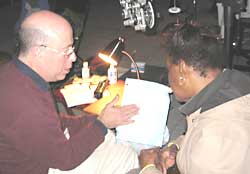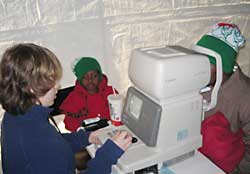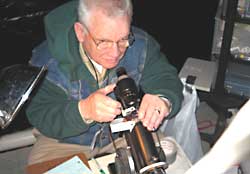Outreach organizations meet ophthalmic need in New Orleans
Thousands of residents in the Gulf Coast region have received eye care from local and long-distance medical groups since Hurricane Katrina.

When Victoria Weiss, OD, traveled to New Orleans to provide eye care to victims of Hurricane Katrina 2 years ago, she did not expect to administer that care at a zoo. However, the Audubon Zoo was one of several unlikely sites where organizations offered ophthalmic services in the aftermath of the storm.
 John A. Hovanesian |
Numerous organizations, companies and programs have been providing eye care to New Orleans and the surrounding areas. Locations for clinics have included the city zoo, parking lots, Federal Emergency Management Agency (FEMA) trailer parks or wherever the most patients can be seen in the shortest amount of time at safe sites, officials said.
Outreach programs have been providing spectacles to correct vision, medication for eye diseases and follow-up care for advanced eye problems to hurricane evacuees and returning residents, Dr. Weiss said.
Dr. Weiss, an optometrist and president of Volunteer Optometrist Service to Humanity-Virginia, has directed a team of volunteer ophthalmologists and optometrists from the medical outreach organization Remote Area Medical Volunteer Corps (RAM) at two winter ocular clinics in the city the past 2 years.
The group worked with fellow outreach organization Operation Blessing International on behalf of the New Orleans Health Department to bring medical, dental and eye care to the region. She said physicians treated more than 1,000 patients at each clinic.
 Victoria Weiss |
Dr. Weiss said the first clinic was conducted in the alligator house of the Audubon Zoo under National Guard protection shortly after the storm and attended by many New Orleans residents. They had lost glasses, eye drops and other ocular care products in the storm and its aftermath. She said residents were overwhelmingly grateful for the outreach care.
This year, the second clinic was conducted in a parking lot and demonstrated that there is still an overwhelming need in the city for ocular outreach, she said.
“I think having the clinic did help, morale-wise, by showing that we do care about what happens because now the residents are not getting as much media attention, and there are still a lot of questions unanswered and a lot of people without solutions,” she said.
Long-distance outreach
In response to the need for medical care in the Gulf Coast region after the hurricane, several long-distance organizations went to New Orleans to assist in providing eye care. John Scanlon, MD, a retired ophthalmologist from New York, went with the Tennessee-based RAM to New Orleans this year.
He assisted in providing medical ocular care, overseeing patients who needed glaucoma drops and administering tests to determine ocular health. Patients had visual acuities taken and their glasses read. An auto-refraction and refraction were done, followed by Goldmann applanation tonometry, if necessary, and then dilation. If patients needed glasses, they were made on the spot, Dr. Scanlon said.
As one of five ophthalmologists in the team, he cared for more than 750 patients alone, he said.
“We try to get them proper ophthalmology service,” he said.
The Bascom Palmer Eye Institute’s Vision Van was also a first responder to New Orleans’ eye care needs. The Vision Van, a 40-foot-long ophthalmic services vehicle, allowed physicians to treat refractive errors and topical inflammation, according to officials from the institute.
After examining patients in the van, ophthalmologists from the Bascom Palmer Eye Institute’s responding team referred some patients to Louisiana State University in Baton Rouge for follow-up care.
|
|
|
|
|
Images: Weiss V |
Local outreach
Some long-distance outreach organizations enlisted the assistance of local volunteer ophthalmologists. Jay LaCour, MD, and colleagues Scott Lanoux, MD, and Joshua Groetsch, MD, were local New Orleans ophthalmologists who worked with RAM to provide continuing care to patients after the clinics.
“What we were able to provide was surgical services and backup here in New Orleans, for both times [after the winter ocular clinics],” Dr. LaCour said. “That’s important because, invariably, when you’ve seen thousands of people come through the clinic, you’ll come across potential problems that need to be addressed surgically.”
Dr. LaCour, a native of New Orleans, returned to the city after the hurricane to find his practice flooded and his home narrowly avoiding the same fate. He decided to stay but said some estimates place the number of ophthalmologists who opted to leave or retire from New Orleans at 17 to 20.
|
Long-distance outreach responders have been invaluable in treating the underserved population in the wake of fewer physicians in the region, he said. With the loss of the city’s Charity Hospital, which was a main provider of eye care for the New Orleans population below the poverty level, and the closure of other hospitals in the city, helping the underserved has been a challenge in the storm’s aftermath, he said. Patients were faced not only with the loss of their medical offices, physicians and paper records but also financial means of obtaining health care. The EENT Foundation helped fund treatment of patients shortly after the storm, as did the Vision Services Plan, he said.
Glaucoma patients were among those most affected by loss of care. Compliance with medication declined sharply, simply because patients lost their medication in the storm or when evacuating or needed refills and could not obtain them. Dr. LaCour said for patients with limited resources, laser trabeculoplasty has become a viable option because it can reduce or eliminate the need for drops.
“We were able to perform that, as well as further treatment, if they needed trabeculectomy or something along those lines,” he said.
The Louisiana State University Eye Center has also been working to meet the needs of glaucoma patients in the city. It conducted a vision screening day, in conjunction with the Friends of the Congressional Glaucoma Caucus Foundation, at Renaissance Village, the largest FEMA trailer park serving displaced New Orleans residents.
Eye center physicians screened patients for glaucoma and other eye disorders with the foundation’s Mobile Eye Screening Unit, a van with devices such as a visual field analyzer. The Eye Center has received a $19,000 grant from the foundation for free glaucoma screenings for New Orleans residents, city officials said.
Marc Bodman, MD, a resident in the university’s ophthalmology program, took part in the screening. He said many glaucoma patients need to be “plugged back into the system” because their records have been lost, and their displaced status has made it difficult for them to re-establish treatment regimes.
“There were some people who hadn’t been on drops in awhile,” he said. “I think this was a good start, and I hope this will continue in the future.”
|
For more information:
- Marc Bodman, MD, can be reached at marc_bodman@yahoo.com.
- Jay LaCour, MD, can be reached at 4324 Veterans Blvd., Metairie, LA 70006; 504-883-7690; e-mail: jaylacour@cox.net.
- John Scanlon, MD, can be reached at jscanlon58@hotmail.com.
- Victoria Weiss, OD, can be reached at 5 Centre Court, Palmyra, VA 22963; 434-591-0262; e-mail: dvcclear@aol.com.
- Erin L. Boyle is an OSN Staff Writer who covers all aspects of ophthalmology.




